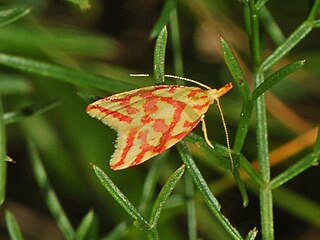
Hypercallia citrinalis is a moth of the family Depressariidae. It is found in Europe, Asia Minor, Georgia, Armenia, Azerbaijan, Mongolia and southern Siberia.

Hypercallia is a genus of gelechioid moths.
The Hypercalliinae are a subfamily of small moths in the family Depressariidae.
Hypercallia sincera is a moth in the family Depressariidae. It was described by Edward Meyrick in 1909. It is found in South Africa.
Hypercallia subreticulata is a moth in the family Depressariidae. It was described by Lord Walsingham in 1881. It is found in South Africa.
Hypercallia heliodepta is a moth in the family Depressariidae. It was described by Edward Meyrick in 1932. It is found in Mexico.
Hypercallia unilorata is a moth in the family Depressariidae. It was described by Edward Meyrick in 1933. It is found in China.
Hypercallia chaldaica is a moth in the family Depressariidae. It was described by Edward Meyrick in 1913. It is found in Argentina.
Hypercallia orthochaeta is a moth in the family Depressariidae. It was described by Edward Meyrick in 1913. It is found in Peru.
Hypercallia diplotrocha is a moth in the family Depressariidae. It was described by Edward Meyrick in 1937. It is found in Argentina.
Hypercallia leucothyrsa is a moth in the family Depressariidae. It was described by Edward Meyrick in 1938. It is found in China (Yunnan).
Hypercallia psittacopa is a moth in the family Depressariidae. It was described by Edward Meyrick in 1912. It is found in Colombia.
Hypercallia arista is a moth in the family Depressariidae. It was described by Lord Walsingham in 1912. It is found in Mexico (Veracruz).
Hypercallia syntoma is a moth in the family Depressariidae. It was described by Lord Walsingham in 1912. It is found in Panama.
Hypercallia longimaculata is a moth in the family Depressariidae. It was described by Paul Dognin in 1905. It is found in Ecuador.
Hypercallia miniata is a moth in the family Depressariidae. It was described by Paul Dognin in 1905. It is found in Ecuador.
Hypercallia bruneri is a moth in the family Depressariidae. It was described by August Busck in 1934. It is found in Cuba.
Hypercallia inguinaris is a moth in the family Depressariidae. It was described by van Gijen in 1912. It is found on Java.
Hypercallia sarcodes is a moth in the family Depressariidae. It was described by Alexey Diakonoff in 1954. It is found in New Guinea.

Halling to Trottiscliffe Escarpment is a 600.6-hectare (1,484-acre) biological Site of Special Scientific Interest which runs from Cuxton to Wrotham, west of Rochester in Kent. It is a Nature Conservation Review site, Grade I. and a Special Area of Conservation.

